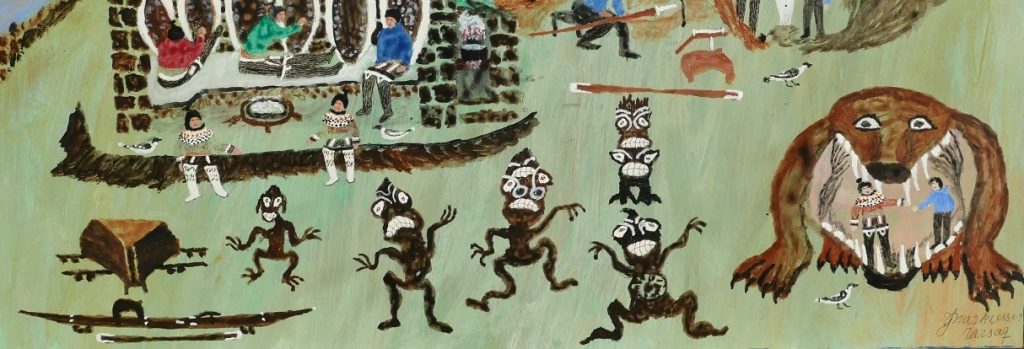 Johan Markussen (1906-1994)
Johan Markussen (1906-1994)
Ujuaangivasik
Flying mythical creatures and tupilak figurines, marvelous beings and dancing humans – is all elements that you can experience in the exhibition with the Greenlandic Artist Johan Markussen at Nuuk Art museum. It is the largest exhibition with Markussen so far, containing more than a hundred paintings and sketches.
Markussen was not an educated artist. He did not have the same urge to explore the world as his contemporary artist Hans Lynge (1906-1988). Markussen was raised in a turf huts in Sissarluttoq, lived all of his life in Narsaq and never wanted to leave. He started painting late in his life and used paint and materials from the local shop – primarily bike varnish and Masonite.
The universe in Markussens paintings stands out from many other artists in the Greenlandic art history. His artistic landscapes are in a way recognizable with the mountains and the sea around and yet they are not a specific place. Some of Markussens works are what he calls ‘nice places to camp’ – with an easy accessible beach, often in a cove and with access to running water. It’s not a specific place, but a characteristic of a good summer campsite.
Markussen is often referred to as a loner in Greenlandic art. He did not mix with the other artists. Markussens works, however, bears witness of an artist, who was both curious and well orientated. His works has small creatures which are almost direct copies of the east Greenlandic artist Kârale Andreassens (1890-1934), with inspiration from Aron From Kangeq(1822-1869) he painted open turf-huts; he recreated bible motives and even drew references to Donald Duck. With humor and wonder he sat the world upside down. Sometimes quite literally, when he in the piece “Silarsuaq killormoortoq – The world upside down”, shows, how it would be if the animals and humans in Greenland switched roles.
The majority of the exhibited pieces are owned by an author, mentor and a friend of Markussen, Kirsten Larsen Egede, who also participates in the opening. Other works of art are borrowed from Narsaq Museum, Greenland National Museum and Archives and from private owners.
The exhibition will last until October 1st 2017– and has been made with the support from Kirsten Larsen Egede and Royal Arctic Line.
